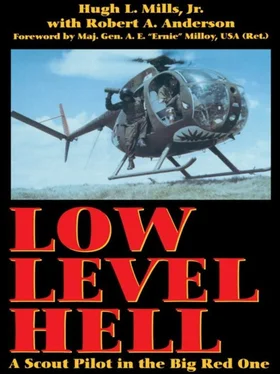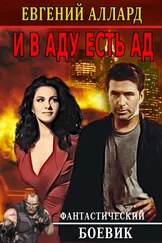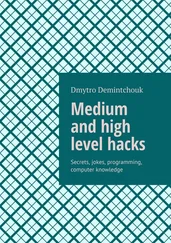The other equipment issued included flight suits, jungle boots, aircraft crewman’s body armor, and a flare gun. Also a strobe light, survival kit, flight gloves, mosquito net, blankets… plus an item I’d never seen before—a blood chit—a large silk document with a big U.S. flag on it and paragraphs of information in several languages. As the supply sergeant handed it to me, he said, “If you get shot down and have to approach a Vietnamese for assistance, he’ll be able to read one of these dialects and know that you’re a downed American pilot in need of friendly help.” Oh, sure, I thought.
The rest of that first afternoon was free and I used it to look around the field. Fortunately, I met one of the troop pilots who was about to fly an OH-6A down to the Saigon PX. He asked if I wanted to ride along. I couldn’t jump in fast enough for my first in-country flight, and in a scout ship at that. I strapped myself in the left seat and immediately began surveying the instrument panel. It was much simpler than the Huey, which carried all kinds of navigational avionics.
I noticed that the pilot and I were sitting in armored seats, which brought home the fact that I was now in a combat zone. There were tungston carbide plates beneath the seats, in the seat backs, and in a wraparound shield that provided partial armor protection to the pilot’s right side, and the co-pilot’s left side. “Chicken plate” was also worn to protect against rounds coming into the aircraft from the front. Of course, that still left your head, arms, and legs as targets of opportunity, but it was a lot better than nothing. Besides the armor protecting the pilot and observer, this combat-equipped OH-6 also had armored engine components, such as the fuel control and compressor unit.
I was surprised by the short, amount of time it took the pilot to get the little OH-6 into the air. The pilot’s hands raced through the pre-flight checks and engine start procedures. We were cranked, checking the tower for takeoff, and in the air before I would have even gotten around to putting my finger on the starter-ignition button.
It was just a 20-minute flight down to Ben Hoa, which was the Air Force’s big base at Saigon, located right next to Tan Son Nhut airport where I had come into country just six days ago. The Ben Hoa base was huge. You could probably see one of every kind of aircraft that the United States had in Vietnam at the time.
We landed at a place called Hotel Alpha, a big, open area with a chain-link fence around it. Our approach was to the large blacktop pad inside the fence, followed by a short hover into one of the available parking spots.
We checked our weapons with the security guard at the gate and walked across the street to the PX. (In later trips to the PX in Saigon, we would avoid checking our sidearms by sticking them under our clothes and telling the gate guard that we weren’t carrying any. Or we would check them with the guard, but have “spares” conveniently stowed away. The command considered Saigon secure and didn’t want soldiers wandering around with guns and no adult supervision, but we always felt more comfortable having our personal weapons on us.)
We were back to the troop by about 1830, and I had logged my first in-country flight. One point three hours of co-pilot flying time. Not exactly airlifting troops to a hot LZ in a slick, but a thoroughly enjoyable trip in an OH-6 scout bird!
My first breakfast in Delta Troop ended up being no breakfast at all. Instead, as I was walking up to the mess hall, all hell broke loose. In the stillness of that early morning, there was the heavy thud of an explosion from the direction of the ARP-crew chief hootch area. I froze.
It was still very dark, at 5:30 A.M. that first morning after I was assigned into the unit. Though officers took their evening meal at the O club, everybody went to the troop mess hall for breakfast and lunch. I had just headed up the troop sidewalk from my hootch, and was adjacent to the orderly room.
It sounded as though the explosion wasn’t more than forty to fifty feet away. Then I heard screaming and cries of pain, telling even this fresh in-country newbie that somebody was badly hurt. My first instinct was to drop into a crouch beside the orderly room, pull out my .45, and chamber a round.
Moments later a man ran around the corner of the building and suddenly appeared in the dark right in front of me. He looked Vietnamese—probably an enemy sapper who had infiltrated the base area and thrown the grenade I just heard.
My .45 was up and on him. Shoot, I told myself, and my finger tightened on the trigger. But in that split second I somehow noticed that he was wearing U.S. camouflage fatigue pants, and boots—shined boots. No black pajamas or sandals!
I released the trigger, and the man stumbled toward me and collapsed into my arms. He was bare chested and had small, bleeding pepper marks all over his upper body where he had evidently been hit by shrapnel. He was not dead, but his eyes were closed and he was obviously in shock and in a great deal of pain.
He was Vietnamese all right, now that I could see his face close up. But why was he wearing our pants and boots?
As I was trying to pull him over to the orderly room and prop him up against the wall, Bob Harris came running up from his hootch just around the corner, his CAR-15 at the ready. “What the hell’s going on?” he demanded.
“I don’t know, but an explosion just went off back in there.” I pointed toward the ARP hootch area.
Harris leaned down close to the man’s face. “You OK, Toi? What happened?”
“Holy shit! Is this one of your guys?”
“Yes, he’s one of my Kit Carson scouts.”
“Thank God,” I groaned. “I nearly put a .45 round right between this guy’s eyes. What do you want me to do now?”
“You stay right here, and I’ll go around this way and see what happened,” Harris snapped as he disappeared around the corner.
A few minutes later, I learned that about six of our men had been hurt by what was thought to be an indiscriminate round that the enemy had lobbed into the ARP-crew chief hootch area. It had landed between the hootches where the men shaved and got cleaned up in the morning. Toi was one of them, and when he was hit by the enemy grenade shrapnel, he ran. Right into my arms.
In just over one day at Phu Loi, I had already seen evidence of my first enemy fire, and had almost shot one of the ARP platoon leader’s prized Kit Carson scouts—former Viet Cong who became indispensable members of our fighting units and were always in short supply.
For the next four days Wayne McAdoo served as my mentor, showing me things that flight school didn’t teach—such as how to land with your tail rotor shot out, combatlike autorotations, tricks of flying under in-country conditions—techniques that were not yet in the books.
I flew more than seven hours in the command pilot’s seat of Wayne’s UH-1D while he sharpened me up for the in-country check flight. I wasn’t too rusty, but it had still been about two months since I had actually been at the controls of a Huey.
Shortly thereafter, I was checked out and declared ready for immediate piloting duty in the lift platoon. As it happened, however, there wasn’t yet room for me there. Not for a week or ten days, until a couple of the guys were rotated back home. Without a permanent slick piloting job, I got my only flying duty in C and C. The usual purpose of these flights was to transport squadron and troop commanders to base camps, fire bases, and night defensive positions (NDPs) for conferences with ground commanders. I flew maybe four C and C missions before a regular piloting opportunity opened up for me to airlift the ARPs.
As much as I grew to admire the work done by those guys in the aerorifle platoon, I never did like being a slick driver for them. Every day during that stint, I watched the early morning hunter-killer visual reconnaissance (VR) teams take off, heading out to find and engage the enemy. I desperately wanted to go.
Читать дальше












